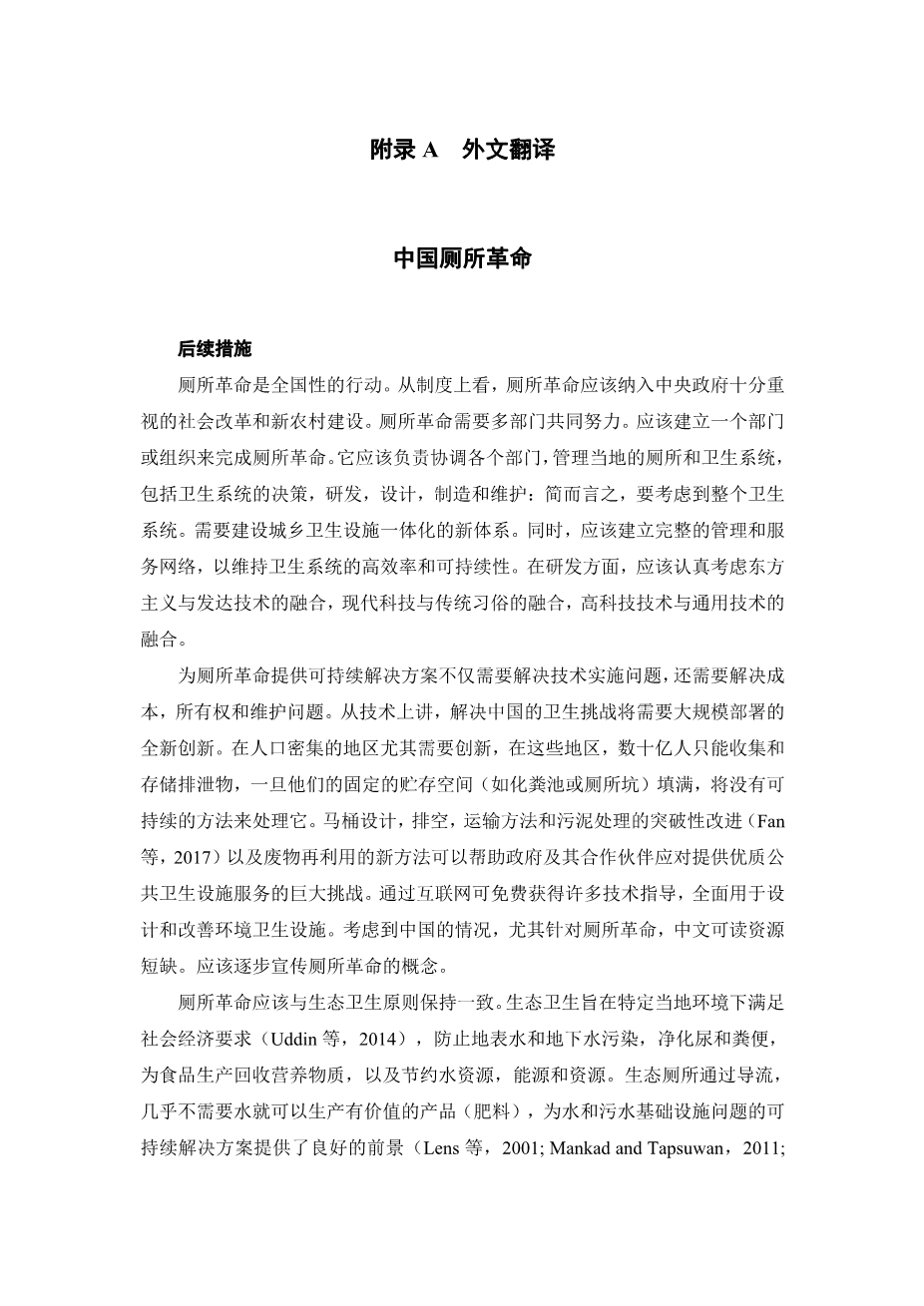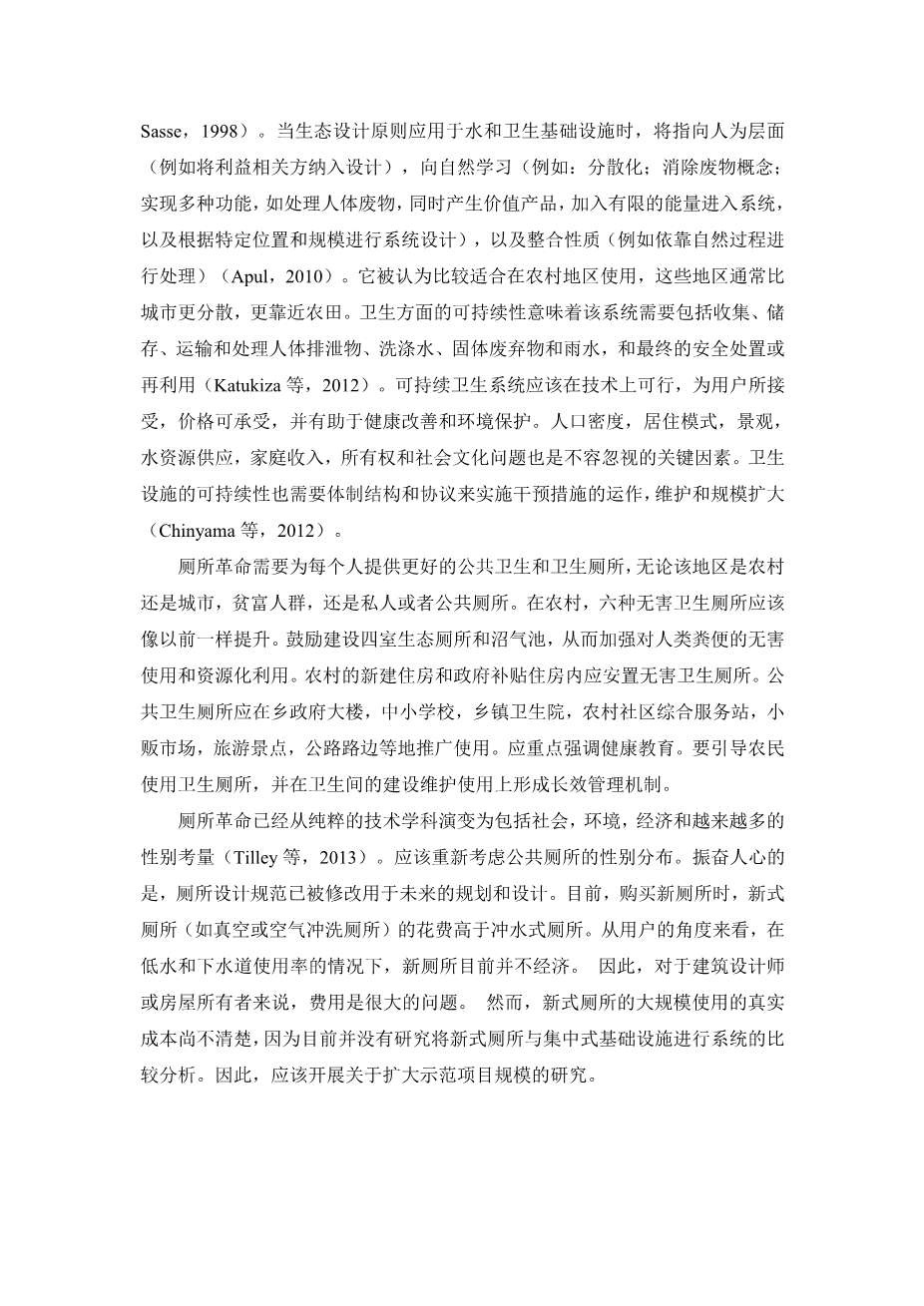附录B 外文原文
- Shikun Cheng,Zifu Li,Sayed Mohammad Nazim Uddin,Heinz-Peter Mang,Xiaoqin Zhou,Jian Zhang,Lei Zheng,Lingling Zhang. Toilet Revolution in China[J]. Journal of Environmental Management,216(2018):347-356
Toilet Revolution in China
- What to do next?
The toilet revolution is a nationwide action. Institutionally, the toilet revolution should be integrated into social reform and new countryside construction, which is highlighted by central government. Toilet revolution requires concerted effort from many departments. It is recommended that one department or organization should be built solely aiming at implementing toilet revolution. It should be responsible for coordinating each department, managing local toilet and sanitation systems, including the decision-making, R amp; D, design, manufacture, and maintenance of sanitation systems: in a word, considering sanitation systems from cradle to grave. A new system should be built, which integrates urban and rural sanitation facilities. Meanwhile, a complete management and service network should be structured to maintain the high-efficiency and sustainability of the sanitation system. In terms of Ramp;D, integration of orientalism and developed technology, modern technology and traditional custom, high-tech technology and common appropriate technology should be taken into consideration carefully.
Providing sustainable solutions for toilet revolution needs to address not only technology implementation but also cost, ownership and maintenance issues. Technologically, solving the sanitation challenge in China will require radically new innovations that are deployable on a large scale. Innovation is especially needed in densely populated areas, where billions of people are only capturing and storing their waste, with no sustainable way to handle it once their on-site storage such as a septic tank or latrine pit-fills up. Ground-breaking improvements in toilet design, pit emptying, transportation method (Fan et al., 2017), and sludge treatment, as well as new ways to reuse waste, can help governments and their partners meet the enormous challenge of providing quality public sanitation services. There is much technical guidance available free of charge via the internet for designing and improving complete access to environmental sanitation. Considering the scenarios in China, especially aiming at toilet revolution, readable resources in Chinese are in shortage. Concept of toilet revolution should be propagandized step by step.
Toilet revolution should be well aligned with the Eco-San principles. The Eco-San aims to meet socioeconomic requirements (Uddin et al., 2014), prevent pollution of surface and ground water, sanitize urine and faeces, recover nutrients for food production, and save water, energy and resources in a given local context. By being decentralized, requiring little to no water, and producing a value product (fertilizer), ecological toilets offer good promise as a sustainable solution to water and wastewater infra- structure issues (Lens et al., 2001; Mankad and Tapsuwan, 2011; Sasse, 1998). When applied to the water and sanitation infrastructure, ecological design principles point to human dimension (e.g. incorporating stakeholders in design), learning from nature (e.g. decentralization; elimination of the concept of waste; meeting multiple functions such as treating human waste while producing a value product, limited energy input to the system, and system design specific to location and scale), and integrating nature (e.g. relying on nature's processes for treatment) (Apul, 2010). It is considered more ready and suitable to be applied in rural areas, where the residence is more decentralized and nearer to farmlands than urban. Sustainability with respect to sanitation implies that the system needs to comprise of collection, storage, transport, and treatment of human excreta, greywater, solid waste and rainwater/ stormwater, as well as the safe disposal or reuse of end products (Katukiza et al., 2012). A sustainable sanitation system should be technically feasible, acceptable to the users, affordable and contribute to health improvements and environmental protection. Population density, settlement patterns, landscape, water avail- ability, household incomes, ownership and sociocultural issues are also key factors that cannot be ignored. Sustainability of sanitation also requires institutional structures and arrangements to be in place for operation, maintenance and upscaling of interventions (Chinyama et al., 2012).
A toilet revolution needs to provide everybody with access to improved sanitation and sanitary toilets, irrespective of whether the area is rural or urban, the people rich or poor or the toilet private or public. In rural areas, the six kinds of harmless sanitary toilets should be promoted as before. It is encouraged to construct a four-chamber eco-toilet and biogas digester, and thereby strengthen the harmless use and resource-oriented use of human faeces. New-built housing and government-subsidized housing in rural areas should be attached to harmless sanitary toilets. Public sanitary toilets should be popularized at township government buildings, primary and middle schools, health clinics in towns and townships, rural community integrated service stations, pedlars' markets, tourist attractions, highway roadsides, etc. Health education should be highlighted. Farmers should be guided to use sanitary toilets, and the long-term effect management mechanism should be formed on the build-maintenance-use of sanitary toilets.
The toilet revolution has evolved from a purely technical discipline to one that includes social, environmental, economic and, increasingly, gender considerations (Tilley et al., 2013). The gender distribution for public toilets should be re-considered. It is inspiring that toilet desig
剩余内容已隐藏,支付完成后下载完整资料


英语译文共 2 页,剩余内容已隐藏,支付完成后下载完整资料
资料编号:[468456],资料为PDF文档或Word文档,PDF文档可免费转换为Word
您可能感兴趣的文章
- COVID-19时期的旅游业和可持续发展:以西班牙为例外文翻译资料
- 农民相对剥夺感对乡村旅游可持续发展的影响机制外文翻译资料
- 校园大学生的旅行行为——以亚洲某乡村大学为例外文翻译资料
- 内容旅游与地方社区响应:鹫宫的“幸运之星”和“协作动漫旅游”外文翻译资料
- 基于符号互动理论的遗产旅游资源开发与重塑——以良渚古城遗址为例外文翻译资料
- 在TikTok上映射互联网名人:探索注意力、经济和可见性劳动力外文翻译资料
- 基于社区游客视角的环境责任行为的概念和度量外文翻译资料
- 温泉小镇的再造:维希的独特案例——副标题外文翻译资料
- 基于IP理念的桐乡丰子恺文化旅游开发研究外文翻译资料
- 特殊事件对旅游业的影响及其应对措施研究——新冠肺炎疫情对全球旅游业的影响及其应对措施外文翻译资料


